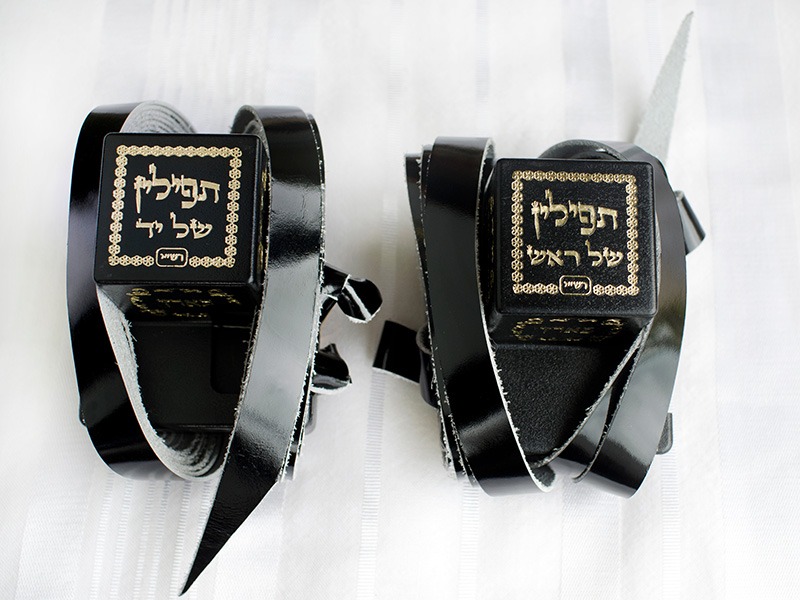A major dispute exists regarding the order of the four passages of tefillin * According to Rashi, the order of the passages is as their order in the Torah * According to Rabbenu Tam, the third passage is “Ve-haya im shamoa”, and the fourth is “Shema” * The kabbalists explained that there is value to both methods, and optimally, there is place to put on both pairs of tefillin * In the Shulchan Aruch, it was decided that the custom is like Rashi, and a God-fearing person should put on both pairs * Most of those who practice today according to the kabbalah, to also put on tefillin of Rabbenu Tam, are Hasidim of Ashkenazi origin
The Dispute
As is well-known, a major dispute exists regarding the order of the four passages of tefillin: “Kadesh” (Exodus 13:1-10), “Ve-haya ki yevi’acha” (Exodus 13:11-16), “Shema” (Deuteronomy 6:4-9), “Ve-haya im shamoa” (Deuteronomy 11:13-21). When in simple terms, according to every opinion, one who practices according to the second opinion does not fulfill the commandment, because as the Gemara says: “Rav Chananel said that Rav said: If one exchanged its passages, i.e., placed them in a different order within the compartment, the phylacteries are unfit.” (Menachot 34b).
According to Rashi, the order of the passages is as their order in the Torah. That is, when standing facing the person who puts on tefillin, on the right side is found the passage of “Kadesh”, after it the passage of “Ve-haya ki yevi’acha”, after it, “Shema” and last from the left “Ve-haya im shamoa”, in other words, parshot ke’sidran (passages in their order). However, according to Rabbenu Tam, the third passage is “Ve-haya im shamoa” and the fourth is “Shema”. That is “havayot in the middle” (passages “Ve-haya” and “Ve-haya” in the middle). And they also disagreed regarding tefillin of the hand (though according to Smak 153, regarding tefillin of the hand, Rabbenu Tam agrees with Rashi).
The dispute is based on the interpretation of the words of our Sages: “Our rabbis taught: How does one arrange them? ‘Kadesh li’ ‘Ve-haya ki yevi’acha’ – on the right, ‘Shema’ ‘Ve-haya im shamoa’ – on the left” (Menachot 34b). According to Rashi, the order is continuous, as the order in the Torah. And according to Rabbenu Tam, if the order were continuous, it would have been necessary to say the order of the passages continuously, and from the fact that they said two on the right and two on the left, we learned that the two on the right begin from the right side inward, and similarly the two on the left begin from the left side inward.
Longstanding Dispute
Apparently, one could ask: Rabbenu Tam is the grandson of Rashi, and it is well-known that all his family members grew up on his Torah, and presumably, the tefillin that Rabbenu Tam received in his youth were according to the method of Rashi; how then suddenly, did he decide to disagree with his great grandfather, and change from the tradition?! But in truth, this dispute has older roots, and for many generations there were many communities that practiced “havayot in the middle” (like Rabbenu Tam), and therefore, when Rabbenu Tam inferred precisely from the Gemara that this is the correct order, he disagreed with his grandfather, and joined in this issue the opinion of the poskim (Jewish law arbiters) who preceded him, as brought in Tosafot (Menachot 34b, “Ve-ha-korei”).
According to the method of Rashi held the Geonim of the Land of Israel and the author of ‘Shimusha Rabba’, and so emerges from the Mechilta of Rabbi Ishmael (Masechet De-Pascha 18), and according to the method of Rabbenu Tam, held Rav Saadia Gaon, Rabbenu Chananel, and the Rif. And according to the opinion of several Rishonim, so practiced also Rav Sherira Gaon and his son Rav Hai Gaon (Tosafot and Rosh). And so it is brought in Tikkunei Zohar (Introduction 9a) in the name of the Jerusalem Talmud.
Testimony of the Rambam
The Rambam, who was born about forty years after Rabbenu Tam, ruled (Laws of Tefillin 3:5) to establish the passages in their order (like Rashi). Following this, the sages of Lunel asked him why he changed from the custom, was it not that “we learned from our teachers and from the Geonim, and Rav Hai Gaon at their head z”l, that we need havayot in the middle” (like Rabbenu Tam). The Rambam answered them (Responsa 489), that initially, his opinion was like their opinion, and so were his tefillin when he was in the Western lands (Spain and North Africa), but when he came to Egypt, he saw that all the people of the Land of Israel and its surroundings practice like Rashi, and he received testimony that so practiced the Geonim of the Land of Israel and Rav Hai Gaon, and therefore, he changed his custom to the method of Rashi. His testimony about the custom of the West matches the words of Rabbi Yehuda of Barcelona who lived about two generations before him, from whose words it emerges that he was not familiar with the method of Rashi.
The Process of Decision
Apparently, until the days of Rashi and Rabbenu Tam, this question had not yet arisen in its full sharpness, and consequently, the law was also not decided, but there were important communities that practiced like Rashi, and there were those who practiced like Rabbenu Tam, and following the objection of Rabbenu Tam to Rashi, as brought in Tosafot, the dispute came to the order of the day. There were those who continued in their custom, and there were those who accepted one of the methods, and there were those who instructed God-fearing people to put on two pairs of tefillin in order to remove the doubt (Terumah, Rosh, Tur and Rabbenu Yerocham).
However, in the study hall of the Ramban, they decided to practice according to the method of Rashi, and did not take into consideration the method of Rabbenu Tam. As wrote the Rashba (Meyuchasot 234), that so practiced Ramban and Rabbenu Yonah. In parallel, also in Ashkenaz the custom of Rashi took root and was established (Mordechai, Laws of Tefillin 669), and so wrote Maharil (137), that they practice like Rashi, and only one who is muchzak u’mifursom b’chasidut (someone with a well-recognized reputation for exceptional religious devotion and righteousness) puts on both pairs.
How the Dispute Arose
A great question arises from the dispute: How is it possible that in a matter where the tradition continued from generation to generation, there arose a fundamental dispute, to the extent that according to each method, one does not fulfill the obligation according to the other method? It is possible to explain, that indeed, this is the disaster of exile, that following the upheavals of exile and evil decrees, the traditions became confused, and thus, an erroneous custom was created, and the Rishonim disagreed what is the correct custom, and what is the mistaken one.
Opinion of the Kabbalists that Both Pairs Have Place
However, the kabbalists explained that there is value to both methods, that each method expresses its own intention and unification, and if so, le’chatchila (optimally), there is place to put on both pairs of tefillin, in order to hint at both intentions. According to this, it is understood that both traditions have ancient roots, and as was clarified when tefillin from the days of the Tannaim were found, that there were some according to the method of Rashi, and others according to the method of Rabbenu Tam.
The Ari wrote (Sha’ar Ha-Kavanot Drushei Tefillin Drush 6), that tefillin of Rabbenu Tam emerge from “mochin de-abba”, and those of Rashi from “mochin de-ima”, and in this world the law is like Rashi, and in the future, like Rabbenu Tam. The foundation of his words is in Tikkunei Zohar Chadash (14a). And the Ben Ish Chai (Vayera 21) even elaborated and wrote that from the days of Moses our teacher, they put on two pairs.
They Did Not Hold that the Order of Passages is Invalidating
As a continuation of this, it can be explained that initially they did not rule that the order of passages is maakev (invalidating), and all the discussion was how it is more proper to fulfill the commandment, and naturally it is understood that there were different methods in this. Moreover, there are interpreters that also the words of the Gemara that the order of passages is maakev, is only according to the method of Abaye, but in truth, the method of Rava (Menachot 35a) is that the order of passages is not maakev. And also, according to those who hold that the order of passages is invalidating, from the Torah it is not maakev (Beshamayim Rosh 24; Rabbi Yitzchak Tayeb author of Erech Ha-Shulchan; Maharsham in ‘Da’at Torah’ 34b; and Rabbi Kasher in supplements to ‘Torah Shleimah’ sign 1).
Ruling of the Shulchan Aruch
In the Shulchan Aruch (Orach Chaim 34:1-3) it is ruled that the custom is like Rashi, and a God-fearing person should put on both pairs, however he emphasized: “One should not do so, except if he has a well-recognized reputation for exceptional religious devotion and righteousness.” And he wrote that one who puts on both pairs should bless on those of Rashi, and should be careful to intend that he is fulfilling the commandment with the pair that is proper according to the truth, while the other is like mere straps, because if not, according to the opinion of many, he will transgress the prohibition of bal toseef from the Torah (the commandment not to add to the Torah’s commandments, or to perform more than what is required) [Bach], or rabbinically (Taz and Machatzit Ha-Shekel), as explained in Mishnah Berurah (34:7), and Yabia Omer (part 1, Orach Chaim 3).
Custom of the Kabbalists
However, the kabbalists disagreed with the ruling of the Shulchan Aruch in two matters. The first, in their opinion one should intend to fulfill the commandment with both pairs, because there is virtue in both of them. The second, in their opinion it is proper for every Jewish male to put on two pairs, and not only for God-fearing people who have a well-recognized reputation for exceptional religious devotion and righteousness (Machazik Berachah Orach Chaim 34:2). So wrote Ben Ish Chai (Vayera 22), and explained that we do not bless on those of Rabbenu Tam because of their exalted status, that we do not have the power to draw down the light that flows from their level.
Opinion of the Gaon of Vilna
In contrast, the opinion of the Gaon of Vilna is that even a God-fearing person with a well-recognized reputation for exceptional religious devotion and righteousness does not need to put on tefillin of Rabbenu Tam, because the law has been decided like Rashi and Rambam. And if we worry about all the different methods in the laws of tefillin, we will need to put on, according to his calculation, twenty-four pairs of tefillin, or sixty-four pairs each day (this is not the place to expand, but indeed, there are additional doubts on the scale of the dispute of Rashi and Rabbenu Tam), but the way to fulfill the commandments of the Torah is as the law that was decided, and as the custom of Israel which is Torah, and therefore, it is sufficient to put on one pair only.
It is told that Rabbi Chaim of Volozhin asked the Gaon of Vilna in his sweet, gentle, respectful manner: “Granted, that our master (the Gra, who wore tefillin all day long) does not put on tefillin of Rabbenu Tam, so as not to nullify even one moment from tefillin, and those of Rashi z”l are primary. But I, who in any case nullify several hours from tefillin, what is the matter if I put on some hours in the day, and fulfill the obligation of tefillin according to all opinions? And he answered him: If you want to fulfill all opinions, you will need to put on 24 pairs”. And in Siach Eliahu, it reads ’64 pairs’. He further asked: “Behold, it is found in the Zohar about tefillin of Rabbenu Tam that they are of the World to Come. And he answered him that the simple meaning of the Zohar is not so, and one who beautifies after the World to Come, should put them on. And from the day he heard words of the living God from his holy mouth, he stopped putting them on”.
The Practical Halakha
In practice, those who’s custom is to follow the halachic poskim, both from Ashkenazi and Sephardic origin, are accustomed to put on tefillin of Rashi only, and only God-fearing people who have a well-recognized reputation for exceptional religious devotion and righteousness, put on also those of Rabbenu Tam, and make a condition that they fulfill the commandment only with the tefillin that are correct according to the truth. And so was the custom in Syria, Iraq and Egypt (Pada et Avraham part 2, p. 292). In Tunisia, they practiced that only the rabbis put on two pairs (Alei Hadas Tefillin 32). In Yemen even the rabbis did not practice to put them on (Etz Chaim, Laws of Tefillin ‘Ve’seder Ha’parshiyot’; Pe’ulat Tzaddik part 3, 216).
So is the custom of students of the Gaon of Vilna, and most of all those who pray in Ashkenazi liturgy, that also most of all the rabbis do not put on tefillin of Rabbenu Tam. So is the custom of Morocco, that almost no one put on tefillin of Rabbenu Tam, including rabbis (Shemesh U-Magen part 3, Orach Chaim 58:4). Those who practice according to the kabbalah put on both pairs, and do not make a condition, because according to the Ari, both pairs are needed, and both are true. In practice, most of those whose custom goes according to the kabbalah to put on also tefillin of Rabbenu Tam, are Hasidim of Ashkenazi origin. Another group practices to put on like Rabbenu Tam, and they are those who practice according to the kabbalah as guided by Rabbi Yosef Chaim, author of ‘Ben Ish Chai’. In practice, it is proper for every person to go according to the custom of his fathers. And if he has a rav muvhak (someone’s primary rabbi, or halachic authority) – as his rabbi’s instruction.
This article appears in the ‘Besheva’ newspaper and was translated from Hebrew.








